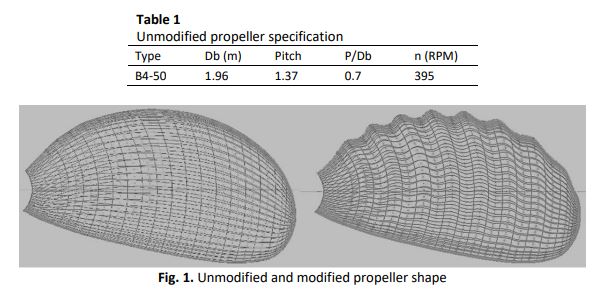Flow Separation Evaluation on Tubercle Ship Propeller
DOI:
https://doi.org/10.37934/cfdl.14.4.4350Keywords:
Efficiency, Flow separation, Propeller, Ship, TubercleAbstract
Propeller design for ship propulsion is important based on efficiency and power output. Advanced propeller design has been proposed in recent research, such as the tubercle propeller. The modified propeller on the leading edge with a tubercle-like design has been improved. Moreover, some evaluation has been studied on the design and performance. In the present study, the tubercle design on the leading edge is evaluated, which focuses on the flow separation effect developed by the tubercle shape. A computational fluid dynamic (CFD) model is compared between the normal and tubercle leading edge. The flow total pressure, Reynold number velocity, and power surface acoustic are evaluated. The flow separation is generated in the leading edge due to the tubercle shape. Moreover, the tubercle shape reduces the total pressure at the propeller blade, especially at the edges. It also increases the Reynold number velocity at the surface due to the flow separation. However, the flow separation decreased the power acoustic surface, which means it lost some power on the propeller.
Downloads
References
Arifin, Mohammad Danil, and Frengki Mohamad Felayati. "Cavitation Analysis of Kaplan-Series Propeller: Effect of Pitch Ratio and nProp using CFD." International Journal of Marine Engineering Innovation and Research 6, no. 2 (2021): 114-124. https://doi.org/10.12962/j25481479.v6i2.8747
Kutty, Hairuniza Ahmed, and Parvathy Rajendran. "Review on Numerical and Experimental Research on Conventional and Unconventional Propeller Blade Design." International Review of Aerospace Engineering 10, no. 2 (2017): 61-73. https://doi.org/10.15866/irease.v10i2.11547
Fish, Frank E. "Biomimetics and the application of the leading-edge tubercles of the humpback whale flipper." In Flow Control Through Bio-Inspired Leading-Edge Tubercles, pp. 1-39. Springer, Cham, 2020. https://doi.org/10.1007/978-3-030-23792-9_1
Chen, Jeng-Horng, and Yu-Shan Shih. "Basic design of a series propeller with vibration consideration by genetic algorithm." Journal of Marine Science and Technology 12, no. 3 (2007): 119-129. https://doi.org/10.1007/s00773-007-0249-6
Shora, Mohammad Mahdi, Hassan Ghassemi, and Hashem Nowruzi. "Using computational fluid dynamic and artificial neural networks to predict the performance and cavitation volume of a propeller under different geometrical and physical characteristics." Journal of Marine Engineering & Technology 17, no. 2 (2018): 59-84. https://doi.org/10.1080/20464177.2017.1300983
Darsono, Febri Budi, Rahmad Doni Widodo, Rusiyanto, and Akhmad Nurdin. "Analysis Of the Effect of Flow Rate and Speed on Four Blade Tubular Water Bulb-Turbine Efficiency Using Numerical Flow Simulation." Journal of Advanced Research in Fluid Mechanics and Thermal Sciences 90, no. 2 (2021): 1-8. https://doi.org/10.37934/arfmts.90.2.18
Aftab, S. M. A., N. A. Razak, AS Mohd Rafie, and K. A. Ahmad. "Mimicking the humpback whale: An aerodynamic perspective." Progress in Aerospace Sciences 84 (2016): 48-69. https://doi.org/10.1016/j.paerosci.2016.03.002
Shi, Weichao, Mehmet Atlar, and Rosemary Norman. "Detailed flow measurement of the field around tidal turbines with and without biomimetic leading-edge tubercles." Renewable Energy 111 (2017): 688-707. https://doi.org/10.1016/j.renene.2017.04.053
Shi, Weichao, Roslynna Rosli, Mehmet Atlar, Rosemary Norman, Dazheng Wang, and Wenxian Yang. "Hydrodynamic performance evaluation of a tidal turbine with leading-edge tubercles." Ocean Engineering 117 (2016): 246-253. https://doi.org/10.1016/j.oceaneng.2016.03.044
Stark, Callum, Weichao Shi, and Moritz Troll. "Cavitation funnel effect: Bio-inspired leading-edge tubercle application on ducted marine propeller blades." Applied Ocean Research 116 (2021): 102864. https://doi.org/10.1016/j.apor.2021.102864
Asghar, Asad, Ruben E. Perez, and William D. Allan. "Further Parametric Investigation of Leading Edge Tubercles on the Propeller Performance." In AIAA Scitech 2019 Forum, p. 0850. 2019. https://doi.org/10.2514/6.2019-0850
Ibrahim, I. H., and T. H. New. "Tubercle modifications in marine propeller blades." In 10th Pacific Symposium on Flow Visualization and Image Processing, pp. 1-11. Naples Italy, 2015.
Butt, Fahad Rafi, and Tariq Talha. "Numerical investigation of the effect of leading-edge tubercles on propeller performance." Journal of Aircraft 56, no. 3 (2019): 1014-1028. https://doi.org/10.2514/1.C034845
Arifin, Mohammad Danil, and Frengki Mohamad Felayati. "Numerical Study of B-Screw Ship Propeller Performance: Effect of Tubercle Leading Edge." International Journal of Marine Engineering Innovation and Research 6, no. 1 (2021): 16-23. https://doi.org/10.12962/j25481479.v6i1.8702
Monsalve-Cifuentes, Oscar Darío, Jonathan Graciano-Uribe, and Diego Andrés Hincapié Zuluaga. "Numerical Simulation of a Propeller-Type Turbine for In-Pipe Installation." Journal of Advanced Research in Fluid Mechanics and Thermal Sciences 83, no. 1 (2021): 1-16. https://doi.org/10.37934/arfmts.83.1.116
Feng, Dakui, Jiawei Yu, Ran He, Zhiguo Zhang, and Xianzhou Wang. "Improved body force propulsion model for ship propeller simulation." Applied Ocean Research 104 (2020): 102328. https://doi.org/10.1016/j.apor.2020.102328
Favier, Julien, Alfredo Pinelli, and Ugo Piomelli. "Control of the separated flow around an airfoil using a wavy leading edge inspired by humpback whale flippers." Comptes Rendus Mecanique 340, no. 1-2 (2012): 107-114. https://doi.org/10.1016/j.crme.2011.11.004
Ibrahim, I. H., and T. H. New. "A numerical study on the effects of leading-edge modifications upon propeller flow characteristics." In Ninth International Symposium on Turbulence and Shear Flow Phenomena (TSFP-9)(accepted). 2015.
Yusvika, Muhammad, Aditya Rio Prabowo, Dominicus Danardono Dwi Prija Tjahjana, and Jung Min Sohn. "Cavitation prediction of ship propeller based on temperature and fluid properties of water." Journal of Marine Science and Engineering 8, no. 6 (2020): 465. https://doi.org/10.3390/jmse8060465
Shin, Keun Woo, and Poul Andersen. "CFD analysis of ship propeller thrust breakdown." In Sixth International Symposium on Marine Propulsors, SMPe19. Rome, Italy. 2019.




























